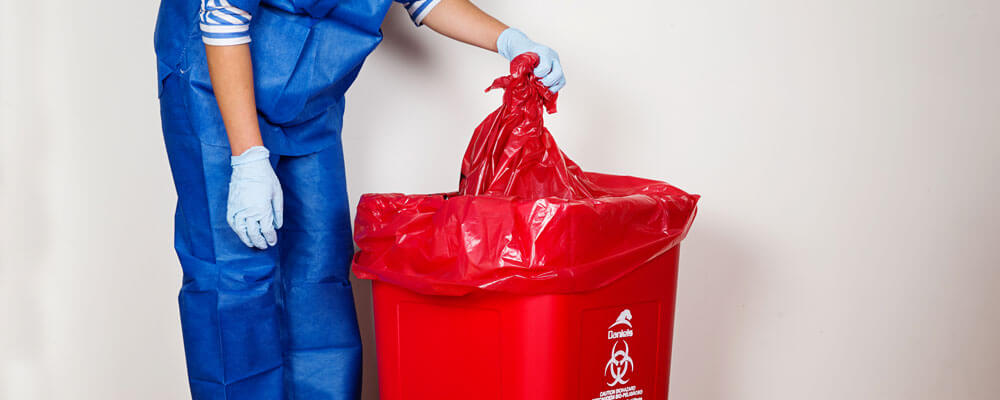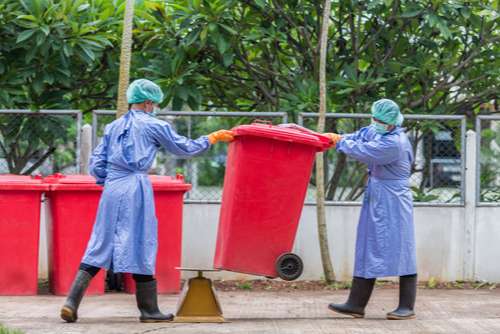Keep Ahead of Regulations: Professional Advice on Medical Garbage Disposal
In a world where the healthcare industry is regularly progressing, it is important for medical centers to remain ahead of laws when it comes to the proper disposal of clinical waste. From understanding the various groups of clinical waste to executing the ideal collection and partition methods, this discussion will certainly provide actionable tips and useful understandings to assist facilities stay ahead of guidelines in the ever-changing landscape of medical waste disposal.
Recognizing Medical Waste Categories
Recognizing medical waste categories is important for appropriate disposal and administration in medical care facilities. Medical waste describes any waste created by medical care tasks that might pose a threat to public health or the atmosphere. It is critical to categorize clinical waste accurately to ensure its secure handling, transportation, treatment, and disposal.
There are numerous groups of medical waste that medical care facilities require to be familiar with. The most common categories include infectious waste, pathological waste, sharps waste, pharmaceutical waste, and chemical waste. Each classification has particular standards and policies for its correct management and disposal.
Transmittable waste includes materials contaminated with blood or various other bodily fluids, such as handwear covers, gowns, and laboratory cultures. Pathological waste refers to human cells, body organs, or body components that need special delivery and disposal. Sharps waste includes used needles, syringes, and various other sharp things that can trigger injury and transmit infections. Drug waste makes up expired, extra, or polluted medicines that require cautious handling and disposal. Chemical waste includes solvents, disinfectants, and various other chemical substances utilized in medical care facilities.
Staying Up-To-Date With Regulatory Adjustments
Staying existing with regulatory modifications is critical for health care facilities to ensure compliance and appropriate monitoring of medical garbage disposal. medical waste removal. With regulations frequently progressing, it is important for medical care centers to stay current to stay clear of charges, fines, and prospective damage to the atmosphere and public health
To remain in advance of regulative changes, medical care facilities should develop a system for monitoring and monitoring updates. This can be done by signing up for governing newsletters, attending workshops and seminars, and actively taking part in market associations. Furthermore, centers must designate a team member or team liable for remaining educated and distributing information to appropriate stakeholders.
Regular communication with regulative agencies is likewise crucial. Healthcare centers should develop connections with neighborhood, state, and government agencies to guarantee they recognize any type of changes in guidelines that might affect their waste administration methods. This can be done with normal meetings, participation in public comment durations, and aggressive involvement with regulative companies.
Moreover, health care centers must think about partnering with waste management companies that specialize in medical waste disposal (medical waste disposal services with WasteX). These firms are often skilled in the most recent laws and can supply assistance and support to ensure compliance
Carrying Out Proper Collection and Partition Methods
To efficiently handle clinical waste disposal, health care facilities should develop appropriate collection and segregation approaches in conformity with governing standards. Executing these methods guarantees the safe handling and disposal of potentially harmful products, safeguards the atmosphere, and minimizes the danger of injuries and infections to medical care employees and the general public.
Appropriate collection and partition methods include making use of assigned containers and labeling systems. Medical care centers ought to offer clearly classified containers for different sorts of clinical waste, such as sharps, transmittable waste, pharmaceutical waste, and non-hazardous waste. These containers need to be color-coded and plainly significant to prevent confusion and advertise easy identification.
Additionally, health care facilities should train their personnel on the appropriate procedures for accumulating and setting apart medical waste. This includes enlightening them on the various kinds of waste, the ideal containers to use, and the significance of complying with guidelines and guidelines. Regular training sessions and refresher training courses must be performed to ensure that employee remain current on best practices.
In addition, healthcare facilities need to establish a system for routine click this collection and disposal of medical waste. This may involve partnering with accredited waste management firms that specialize in medical garbage disposal. These firms will certainly ensure that the gathered waste is transported and gotten rid of in conformity with regulatory demands.
Choosing the Right Disposal Techniques

Incineration is just one of the most common and effective methods for throwing away particular kinds of clinical waste, such as pathological waste and sharps. It entails the regulated burning of waste at high temperature levels, minimizing it to ash. Incineration can release damaging contaminants into the air and contribute to air contamination.

Chemical therapy includes the usage of chemicals to counteract the waste and decontaminate. Microwave therapy makes use of microwave power to warmth and decontaminate the waste.
Making Certain Conformity Via Documents and Training
After meticulously considering the appropriate disposal methods for clinical waste, medical care centers need to make sure conformity with policies and reduce environmental impact by implementing reliable documents and training treatments. This step is essential in maintaining a lasting and risk-free environment for both healthcare employees and the public.

Healthcare workers who handle medical waste needs to obtain ideal training on waste partition, handling, and disposal treatments. By giving thorough training, medical care centers can encourage their personnel to make educated decisions and minimize the risk of inappropriate waste disposal.
Verdict
To conclude, staying ahead of regulations in clinical garbage disposal is vital for health care facilities. medical waste removal service. Comprehending the different categories of medical waste, remaining updated with governing adjustments, implementing correct collection and segregation approaches, selecting the ideal disposal approaches, and making sure compliance through documents and training are all necessary steps. By adhering to these standards, healthcare companies can efficiently manage and get rid of of medical waste in a secure and accountable manner
From recognizing the different groups of medical waste to applying the ideal collection and segregation techniques, this discussion will give actionable pointers and important understandings to help facilities remain ahead of guidelines in the ever-changing landscape of medical waste disposal. - medical waste disposal services with WasteX
The most typical groups consist of infectious waste, pathological waste, sharps waste, pharmaceutical waste, and chemical waste. Healthcare facilities ought to offer clearly identified containers for different types of medical waste, such as sharps, contagious waste, pharmaceutical waste, and non-hazardous waste. Health care facilities must establish a detailed system to tape and track all elements of clinical waste disposal, including types of waste produced, quantities, and disposal methods used. Healthcare employees that take care of clinical waste must get proper training on waste segregation, dealing with, and disposal procedures.